|
Quality Quartz Filters
The quartz filter selected on the selectivity board is cascaded with the roofing filter selected on the frontend board. Together they set the ultimate selectivity of the receiver. The shape factor will be largely defined by the more rectangular quality quartz filter on the selectivity board. The stop-band isolation will be the sum of the roofing filter and the quality filter, providing very large stop-band attenuation already very close-in.
There is a clear trade-off between selectivity and phase linearity. Good phase linearity is required for good sounding signals in the baseband. Brick-wall type filter skirts are required for stopping close-in strong out of channel signals. It is not easy to fulfill both requirements with analog quartz filters. Especially with CW phase linearity is very important. Very narrow CW filters can suffer from severe ringing which does defeat the intelligibility of the signal.
Also the IMD introduced by the non-linearity of the quality quartz filter is a key parameter. The out-of-band intercept for the filters on the selectivity board are of lesser importance as they are protected for strong out-of-band signals by the roofing filter on the frontend board. More important is the in-band intercept of the quality filters. The in-band IMD will noticeable as distortion especially for SSB. In the down-conversion case described here, the roofing filters are only just slightly wider than the quality filters, which define the channel width. The in-band IMD of the roofer together with the in-band IMD of the quality filter define how well the in-channel signal sounds. The out-of-band intercept of the roofing filter together with the receivers noise floor (MDS) sets the out of channel 3rd order IMD dynamic range (IMD3DR). With this filter configuration there is almost no area where very strong out of channel signals that are inside the roofing filter and outside the quality filter can cause IMD inside the channel.
INRAD SSB Filter
The INRAD #2310, a 9MHz, 8-pole, 2400Hz wide SSB filter has been tested to serve on the selectivity board. It has a design impedance of 500Ω. In order to match this filter to a 50Ω system, low-pass L-matches at both ends are used. The series L=2.653uH and the shunt C=106pF to give a match from 50Ω to 500Ω and the other way around. Both L and C are made adjustable in order to be able to precisely match the filter. The L is implemented with a shielded coil former, Lodestone L45-6 (yellow), with 18 turns of 0.3mm enameled copper wire. The C is implemented with a 40p green Philips foil trimmer parallel with an 82p COG ceramic MLCC. The L45-6 will perform well in this situation. It is shielded so leakage from input to output hurting the stop-band is minimal and its adjustable slug is very convenient to get the best possible match. The loaded Q of the L-match is relatively low so IMD caused by the iron-powder core material will not be significant compared to the probably non-stellar in-band IMD of the quartz filter. Likewise with the C0G type ceramic capacitor.
3rd Order Intermodulation
The following table shows the out-of-band IMD3 performance of the INRAD #2310 SSB filter with 20KHz separated 2-tones at various levels. The IIP3 is around +38dBm, but slowly degrades for lower signal levels, which is a sign of slight non 3rd order law behavior. Still this is a good result for this commercial 8-pole SSB filter.
| INRAD #2310 2.4KHz SSB filter, 20KHz separated 2-tones |
| Level (dBm) |
IMD 1 (-dBc) |
IMD 2 (-dBc) |
IIP3 1 (dBm) |
IIP3 2 (dBm) |
IIP3 avg (dBm) |
| 5,8 |
69 |
69 |
40,3 |
40,3 |
40,3 |
| 3,9 |
71 |
70 |
39,4 |
38,9 |
39,2 |
| 2,0 |
73 |
72 |
38,5 |
38,0 |
38,3 |
| 0,0 |
76 |
75 |
38,0 |
37,5 |
37,8 |
| -1,9 |
80 |
79 |
38,1 |
37,6 |
37,9 |
| -3,9 |
84 |
81 |
38,1 |
36,6 |
37,4 |
| -5,9 |
87 |
84 |
37,6 |
36,1 |
36,9 |
| -7,9 |
91 |
88 |
37,6 |
36,1 |
36,9 |
More important behind the roofing filters is the in-band IMD3 performance. This is shown for 100Hz separated 2-tones and various 2-tone levels in the following table. The IIP3 is around +30dBm for the higher input levels. However when the IMD products are reduced to about -66dBc at input level -3.9dBm and below, then 3rd order behavior is completely lost. It is only at much lower input levels at the bottom of the table that the IMD begins to drop below the -66dBc values. The table shows that the OIP3 of the LNA and switches on the selectivity board should be higher than +30dBm, preferably with a large margin, say > +36dBm in order to have no effect on the resulting IMD at all.
| INRAD #2310 2.4KHz SSB filter, 100Hz separated 2-tones |
| Level (dBm) |
IMD 1 (-dBc) |
IMD 2 (-dBc) |
IIP3 1 (dBm) |
IIP3 2 (dBm) |
IIP3 avg (dBm) |
| 5,8 |
46,4 |
46,4 |
29,0 |
29,0 |
29,0 |
| 3,9 |
52,0 |
52,8 |
29,9 |
30,3 |
30,1 |
| 2,0 |
57,2 |
57,2 |
30,6 |
30,6 |
30,6 |
| 0,0 |
61,2 |
62,0 |
30,6 |
31,0 |
30,8 |
| -1,9 |
65,2 |
66,4 |
30,7 |
31,3 |
31,0 |
| -3,9 |
66,8 |
66,8 |
29,5 |
29,5 |
29,5 |
| -5,9 |
65,6 |
64,8 |
26,9 |
26,5 |
26,7 |
| -7,9 |
65,6 |
65,6 |
24,9 |
24,9 |
24,9 |
| -9,9 |
64,4 |
64,4 |
22,3 |
22,3 |
22,3 |
| -12,0 |
66,0 |
66,0 |
21,0 |
21,0 |
21,0 |
| -14,0 |
67,2 |
67,2 |
19,6 |
19,6 |
19,6 |
| -16,0 |
68,2 |
68,2 |
18,1 |
18,1 |
18,1 |
| -18,0 |
71,3 |
71,3 |
17,7 |
17,7 |
17,7 |
| -20,0 |
74,4 |
74,4 |
17,2 |
17,2 |
17,2 |
The non-3rd order law in-band IMD behavior of the #2310 causing the IIP3 to fall from +30dBm to +17dBm is a bit disappointing but was expected. The worst case value for the IIP3 should probably be set at +17dBm. However the intercept point, as pointed out in the introduction, is a less meaningful characterization for in-channel IMD. At extreme input levels like -6dBm at the antenna (S9+67dB) the IMD at the output of the selectivity board is already 66dB below the wanted signal and probably not noticeable by ear as distortion by most of us! The -65dBc or better result at input signals of -2dBm or less is a good result and actually much better than needed in practice given the fact that solid state LPA's used by amateurs usually produce IMD levels of around -30dBc. This makes the #2310 SSB filter, from a 3rd order IMD point of view, a good choice to provide channel selectivity behind the high intercept QT quartz roofing filters. The following screen shot shows the worst case scenario of IMD visible at the output of the selectivity box. So this is the combined IMD of the LNA the switches and the SSB crystal filter at an extremely high input signal level:
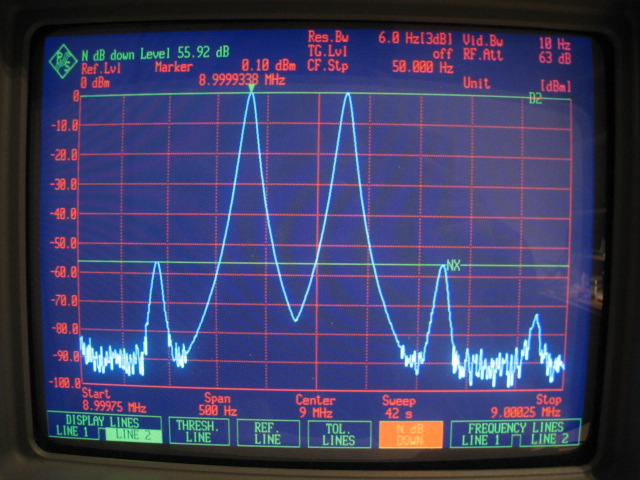
The OIP3 is +28dBm. With the 2.3dB insertion loss of the filter this translates to a +30.3dBm IIP3 seen at the filter input. This shows that the LNA and the switches on the selectivity board do not add any additional IMD, which is one of our design goals.
Selectivity
The following N2PK VNA plot shows a 5KHz wide scan of the #2310. Note that all scans have been made with the filter between a pair of FSA3157 SPDT switches. The additional insertion loss introduced by the bus switches is -0.7dB. This sets the IL of the filter at around -2.3dB at the center (Mrkr1). The -3dB points are defined by Mrkr2 and Mrkr3 and show a -3dB bandwidth of 2437Hz. The -60dB bandwidth is 3625Hz, so the -60dB/-3dB shape factor is 1.49 which is within the 1.50 claimed by INRAD. This is the kind of picture (without stop-band) we usually get to see of a properly matched commercial crystal filter, although a small sign of trouble is already visible in the lower left corner.

A wider 20KHz wide plot is shown in the following graph and drills deeper into the stop-band and shows its limitations. The ultimate stop-band of the #2310 is around the -90dB level. I have not been able to get more stop-band out of this unit. On its own, this performance is clearly insufficient for a high dynamic range receiver, but luckily we also have the 4-pole roofing filter on the frontend board that will help us out.
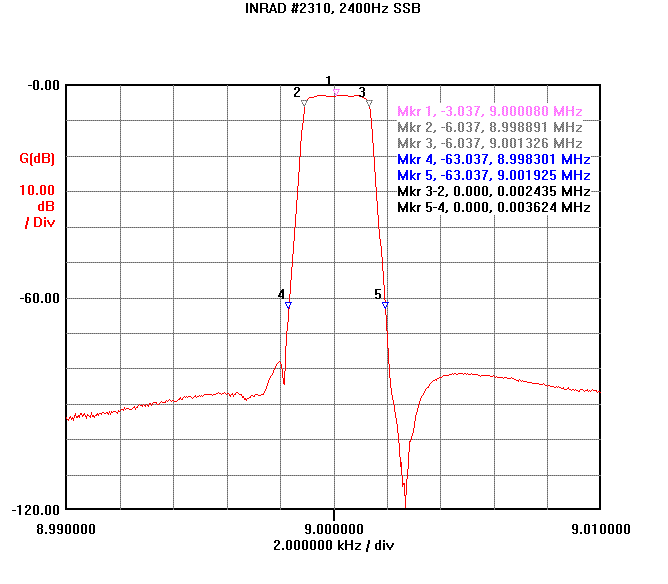
A 3KHz wide plot showing the upper 10dB together with the filter's group delay is shown in the following graph. We finally do see some ripple now, but the ripple is really minimal for most of the pass-band, only 0.2dB or less. This is what can be achieved when both C and L are adjustable! There is a bit more ripple at the left end of the graph and this is immediately quite noticeable in a group-delay at the lower skirt with a higher peak. It was impossible to tune this effect away with the L-matches, so it came built-in with the filter. Nevertheless this is a very good result! The difference in group-delay between the center and the skirts is around 1.5mS, which will cause some distortion of the resulting baseband audio signal.
It can also be seen that the center of the filter is slightly off, 104Hz too high. There is nothing that we can do about it, but fortunately it is still just within the roofing filter.
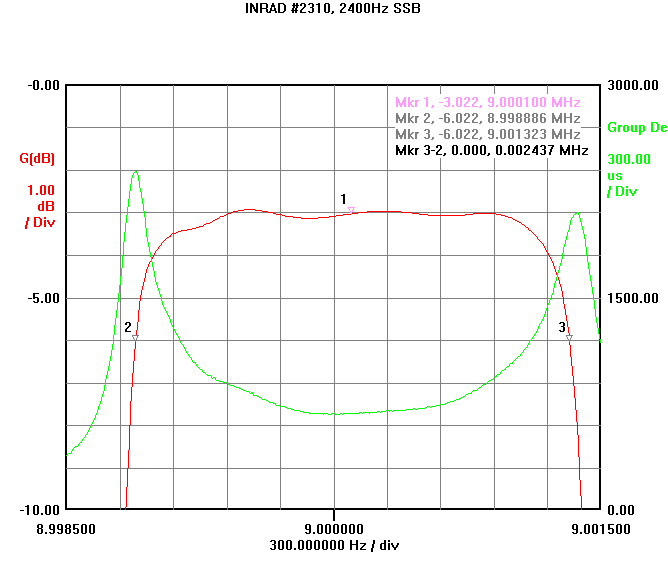
It is interesting to see how the SSB roofing filter cascaded with the #2310 filter performs. The following graph shows the combined selectivity of the frontend board (excluding the H-Mode mixer), the selectivity board with LNA and switches and the #2310 SSB filter:
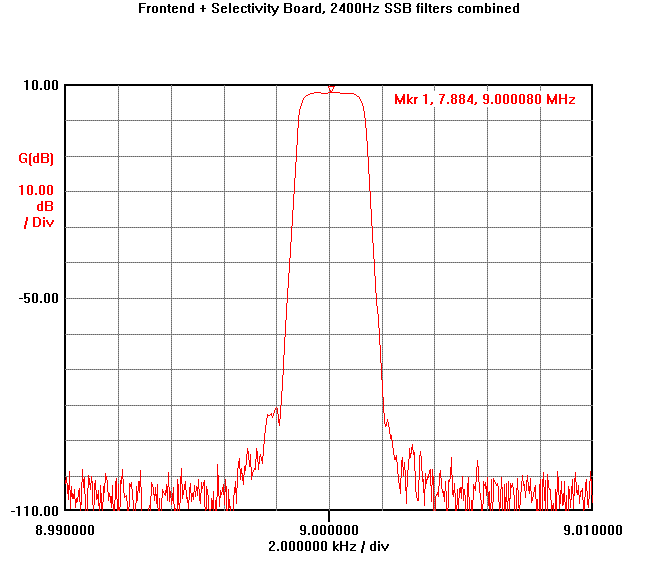
A dynamic range close to 120dB is shown directly on the VNA. However the noise floor of the VNA is the limiting factor in this graph. Further out the roofing filter alone provides over 100dB of stop band. Combined with the stop band of the #2310 this could mount up to 180dB, provided that coax cables interconnecting the boxes have no leakage.
The gain inside the pass-band is 7.9dB. This is the gain from the output of the H-Mode mixer to the output of the selectivity box. This shows that the LNA on the selectivity box provides more than enough gain to compensate for the #2310 filter insertion loss.
The picture above also shows how high the bar is set regarding the effects of reciprocal mixing of LO side-band noise. There is not too much point in this kind of close-in stop-band filter performance if the LO's sidebands (PM/AM noise) cause that noise to be reciprocally mixed into the filter pass-band when a very strong signal is present just outside the pass-band! This is what makes the AM-noise plateau problem with ADI's AD9910 and AD9912 DDS's such a regrettable bummer!
Finally the pass-band with group-delay is shown in the following graph for the frontend board + selectivity board, and again without the mixer and the antenna filter:
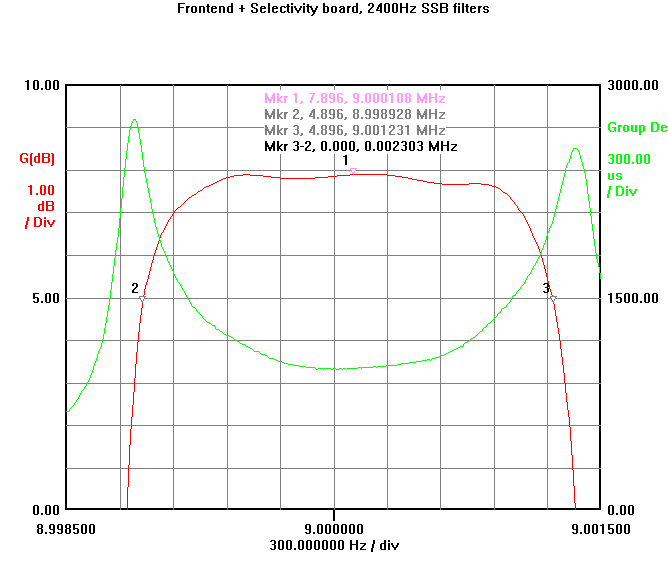
The roofing filter is a 4-pole Butterworth design and does not add significantly to the combined group-delay. The difference in group-delay between the center and the skirts is still around 1.5mS.
INRAD CW Filter
For narrow band modes like CW, the INRAD #2304, a 9MHz 8-pole 500Hz wide filter has been tested on the selectivity board. Like the #2310 SSB filter, it features a design impedance of 500Ω. Therefore the same L-match configuration can be used as described for the SSB filter. The next paragraphs describe the measurement results of this filter.
3rd Order Intermodulation
The out-of-band 20KHz spaced IMD3 performance is shown in the following table. The IIP3 is really high around +44dBm and even slightly increases for lower signal levels!
| INRAD #2304 500Hz CW filter, 20KHz separated 2-tones |
| Level (dBm) |
IMD 1 (-dBc) |
IMD 2 (-dBc) |
IIP3 1 (dBm) |
IIP3 2 (dBm) |
IIP3 avg (dBm) |
| 5,8 |
75 |
75 |
43,3 |
43,3 |
43,3 |
| 3,9 |
80 |
80 |
43,9 |
43,9 |
43,9 |
| 2,0 |
85 |
85 |
44,5 |
44,5 |
44,5 |
| 0,0 |
91 |
91 |
45,5 |
45,5 |
45,5 |
| -1,9 |
95 |
95 |
45,6 |
45,6 |
45,6 |
The in-band 100Hz spaced IMD3 of the #2304 is shown in the following table. The IIP3 is quite consistent around +18dBm level for the higher input levels, but like the SSB filter it completely loses its proper 3rd order law behavior for input signals below -4dBm. IIP3 drops considerably from +18dBm to -1dBm! The good news is that the IP3 stabilizes at -1dBm and regains 3rd order law behavior for signals below -28dBm. The discussion about how in-channel IMD is best characterized certainly also applies to the CW filter. IP3 is less meaningful, but dBc values are. Except for extremely strong in-channel signals, the IMD is 54dB below carrier or better.
| INRAD #2304 500Hz CW filter, 100Hz separated 2-tones |
| Level (dBm) |
IMD 1 (-dBc) |
IMD 2 (-dBc) |
IIP3 1 (dBm) |
IIP3 2 (dBm) |
IIP3 avg (dBm) |
| 5,8 |
25,2 |
24,8 |
18,4 |
18,2 |
18,3 |
| 3,9 |
29,2 |
29,2 |
18,5 |
18,5 |
18,5 |
| 2,0 |
33,2 |
33,2 |
18,6 |
18,6 |
18,6 |
| 0,0 |
37,6 |
37,6 |
18,8 |
18,8 |
18,8 |
| -1,9 |
42,0 |
42,4 |
19,1 |
19,3 |
19,2 |
| -3,9 |
45,2 |
46,0 |
18,7 |
19,1 |
18,9 |
| -5,9 |
46,8 |
48,0 |
17,5 |
18,1 |
17,8 |
| -7,9 |
46,8 |
48,4 |
15,5 |
16,3 |
15,9 |
| -9,9 |
50,6 |
50,6 |
15,4 |
15,4 |
15,4 |
| -12,0 |
52,4 |
52,4 |
14,2 |
14,2 |
14,2 |
| -14,0 |
53,4 |
53,4 |
12,7 |
12,7 |
12,7 |
| -16,0 |
53,4 |
53,4 |
10,7 |
10,7 |
10,7 |
| -18,0 |
54,0 |
54,0 |
9,0 |
9,0 |
9,0 |
| -20,0 |
54,0 |
54,0 |
7,0 |
7,0 |
7,0 |
| -22,0 |
54,0 |
54,0 |
5,0 |
5,0 |
5,0 |
| -24,0 |
54,0 |
54,0 |
3,0 |
3,0 |
5,0 |
| -26,0 |
54,0 |
54,0 |
1,0 |
1,0 |
1,0 |
| -28,0 |
54,0 |
54,0 |
-1,0 |
-1,0 |
-1,0 |
| -30,0 |
58,0 |
58,0 |
-1,0 |
-1,0 |
-1,0 |
| -32,0 |
62,0 |
62,0 |
-1,0 |
-1,0 |
-1,0 |
The IMD3 measurement results of the SSB and CW INRAD filters do show very interesting trends also observed with the homemade QT-quartz roofing filters on the frontend board:
-
The out-of band IP3 of the 500Hz filter is higher than the out-of-band IP3 of the 2400Hz filter in both cases.
-
The in-band IP3 of the 500Hz filter is lower than the in-band IP3 of the 2400Hz by about 12dB in both cases.
Although the in-band IP3 of the #2304 is much lower than what the frontend board is capable of, this filter is a good candidate for the selectivity board. The probability of strong CW signals inside the 500Hz filter causing IMD that will be noticeable by ear is very limited. The strong signals will both be in-channel and the much weaker IMD products will be largely irrelevant. The following picture shows the worst case scenario of IMD visible at the output of the selectivity box. So this is the combined IMD of the LNA, the switches and the CW crystal filter at an extremely high input signal level:
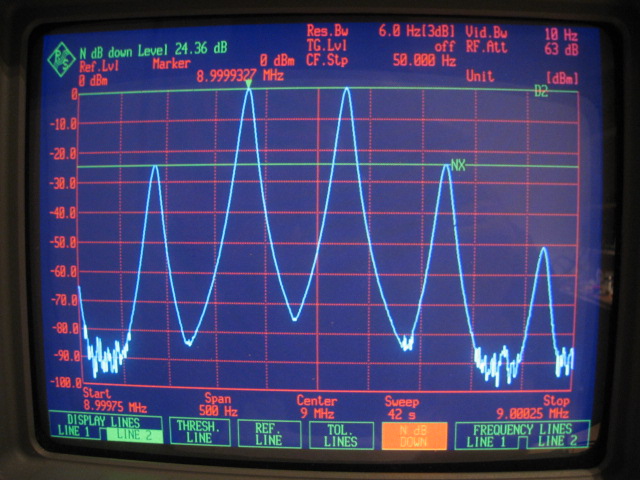
The IMD products are only -24.4dBc. Therefore the OIP3 seen on the picture is +12.2dBm. Taking into account the insertion loss of 6.2dB of the filter, the IP3 referred to the filters input is +18.4dBm. Clearly no additional IMD is introduced by the LNA and the switches. The two IMD products in the picture look quite dramatic, but don't forget that the level of the output signal is 0dBm! This would translate to two +4dBm signals at the antenna entering the frontend. This is equivalent to two S9+77dB (S22-1dB) signals inside the 500Hz pass-band of the filter. Although the #2304 filter does not show proper 3rd order law IMD behavior all the time, the IMD products will drop down quickly to -54dBc or better with more practical input levels like S9+60dB or less. Unless you are so unfortunate to have 2 QRO HAM's as neighbors that are competing with you in the same pile-up and transmitting when you are receiving... It is unlikely that the in-channel -25dBc IMD produced by the #2304 filter will be your biggest concern in that extreme scenario!
Selectivity
The following N2PK VNA plot shows a 1.5KHz wide scan of the #2304. The filter is nicely centered on 9MHz, with only a slight offset to the right (19Hz). Its insertion loss is 6.2dB. (0.7dB is accounted for by the FSA3157 SPDT switches). The -3dB points are defined by Mrkr2 and Mrkr3 and show a -3dB bandwidth of 462Hz. The -60dB bandwidth is 1163Hz. This puts the -60dB/-3dB shape factor at 2.51. The -6dB bandwidth is 551Hz, so the -60dB/-6dB shape factor is 2.11. This is quite close to the figures provided by INRAD. The shape of the transmission plot of the #2304 is much more rounded than the #2410 plot. This is to be expected of a more phase linear and over 4 times narrower CW filter.
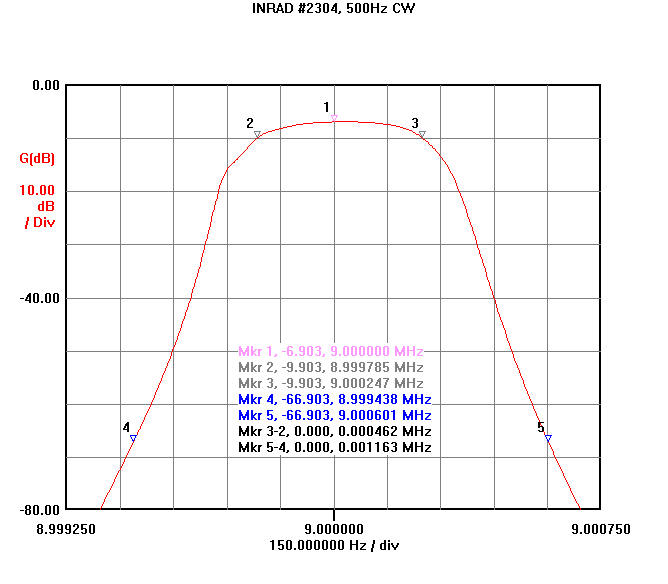
Now we will zoom out a bit so that we can see the stop band performance of this filter. The stop band is reached at around -85dB. This seems to be a limitation of the unit. Like with the SSB filter this is not going to be sufficient on its own in a high dynamic range receiver. And again the corresponding 500Hz roofing filter will help us out with the stop-band.

More details of the pass-band are shown in the following 750Hz wide sweep. Any ripple of the 8-pole filter is swamped by the -6.2dB insertion loss. Interesting is the group-delay. The slight asymmetry at the left side of the insertion loss curve shows as a much bigger peak in the group-delay. Still the total delta of the group-delay is about 2.5mS. If the filter would not have had the anomaly at its lower skirt, the delta could have been only 1.2mS. This shows that this filter has been designed with much more phase-linearity in mind than the wider SSB filter. In practice on the bands it sounds acceptable not obscured with much ringing.
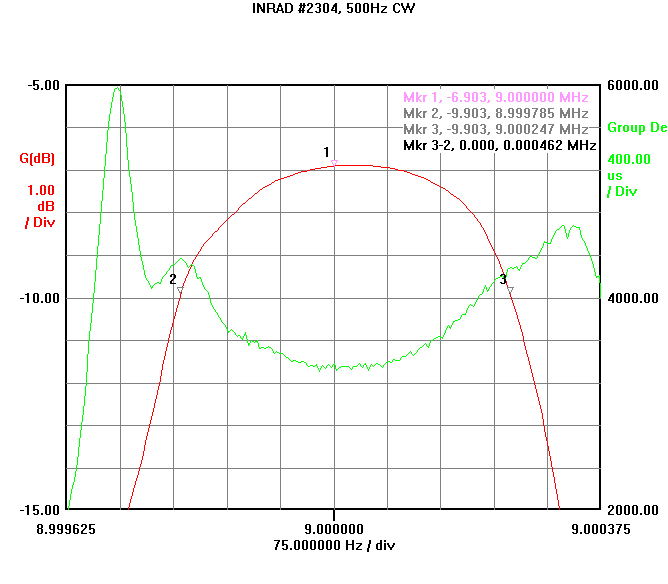
The following graph shows the combined selectivity of the frontend board (excluding the H-Mode mixer), the selectivity board with LNA and switches and the #2304 CW filter. The stop-band limitation of the #2304 is fully resolved by the cascaded action of the 500Hz roofing filter. Again the noise floor at -105dBm is the limit of the VNA, so the actual stop-band attenuation will be much more. The roofing filter alone already provides in excess of 100dB attenuation in the stop band, so the combined stop band could be as much as 180dB if the coax cables interconnecting the boxes are not leaking at all!
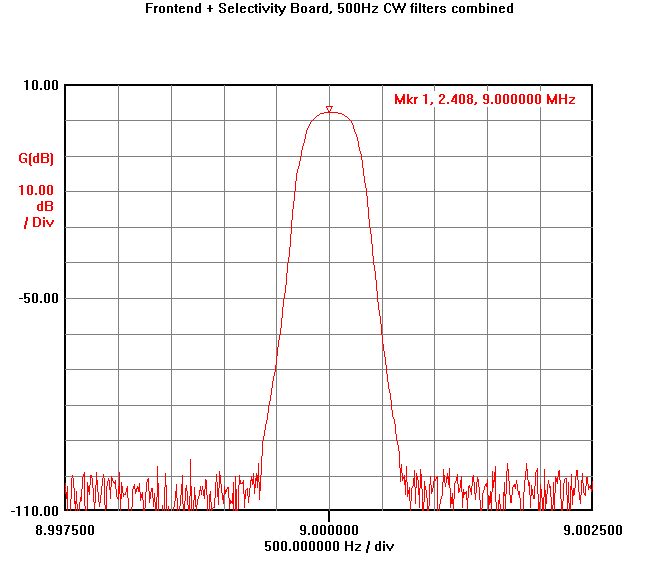
The gain inside the pass-band is +2.4dB. This is the gain from the output of the H-Mode mixer to the output of the selectivity box. There is still gain which shows that the LNA on the selectivity box is providing enough gain to compensate for the higher losses in the 500Hz #2304 filter. This shows that the cumulative total NF of the receiver will be set mainly by the frontend as it should and that 6dB additional sensitivity can be obtained from the reduction in bandwidth from 2400Hz to 500Hz in the CW case.
Finally the pass-band with group-delay is shown in the following graph for the frontend board + selectivity board, and again without the mixer and the antenna filter:
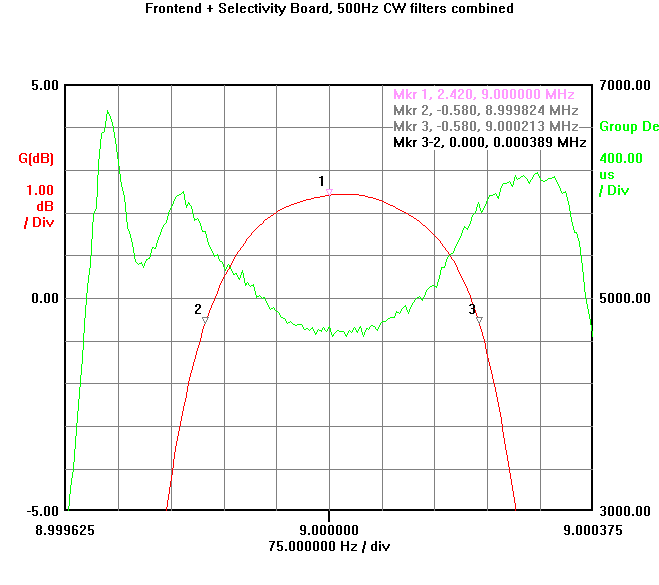
The roofing filter is a 3-pole Butterworth design and does not add significantly to the combined group-delay. The difference in group-delay between the center and the skirts is slightly reduced and around 1.8mS. This is a good result compared with the SSB filter situation.
Conclusion
The measurements show that the INRAD filters are of good quality and will perform well on the selectivity board. The in-band IMD does not follow 3rd order law at all, but the dBc values of the IMD are sufficiently low not to cause noticeable in-channel distortion. Interesting are the similarities between the roofing filters and the INRAD filters when looking at IMD behavior comparing CW and SSB filters. Again there seems to apply a 6dB per octave rule for increasing in-band intercept with increasing bandwidth. Quartz filters in a can, like the INRAD filters, cannot provide all the stop-band attenuation needed in a high dynamic range receiver. Additional poles of filtering are needed with similar bandwidth to provide the ultimate close-in stop-band. In case of a down conversion architecture this can simply be provided by 4-pole SSB and 3-pole CW roofing filters without much additional phase distortion. This is a big advantage of the down conversion scheme! Although the combined bandwidth of the 500Hz CW roofer and the 500Hz #2304 is only 390Hz, an even narrower CW filter can be useful provided that the ringing can be contained.
Filters
Switches
Pre-Amplifier
Back to Selectivity Board
Back to the TOC
|